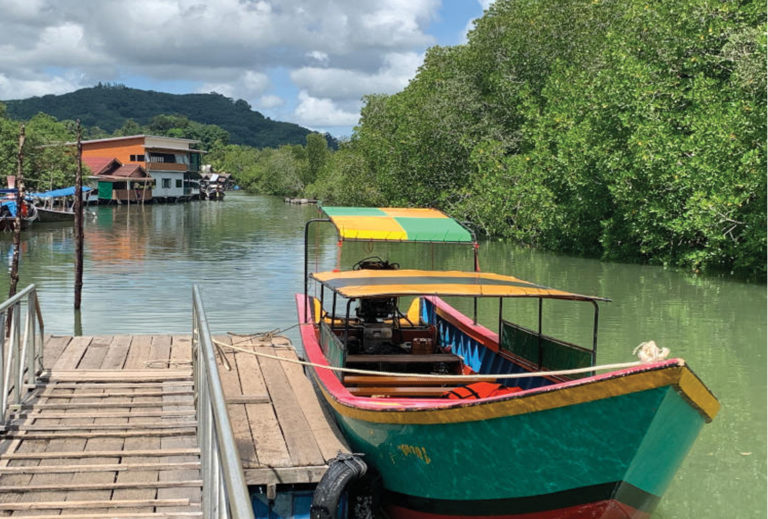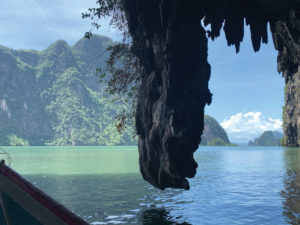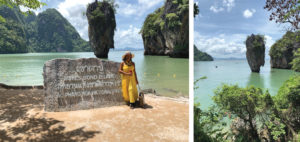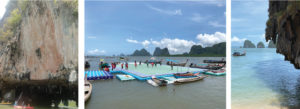Exploring the incredible beauty of Phang Nga by traditional long-tail boat

By Kim Waddoup
Nothing can prepare you for the scale and magnificent scenery of Phang Nga. I have travelled extensively yet this is one of the most incredible scenes of nature’s extraordinary works of art I have ever seen. Looking from the mainland over the mangroves and out across the bay there are incredibly shaped islands, each one unique in shape and size.
Formally a barrier reef during the Permian epoch, (298-252 million years ago) the formations are the result of geological movements and fractures. Wind, ocean currents and sea corrosion have all shaped these islands and the limestone karsts are still being continuously re-sculptured by the elements..
During our stay on Phuket, we were constantly hounded by touts for boat trips across the bay.. They sounded idyllic with high-speed boat, tour guide, lunch, snorkelling and sightseeing all included. However, we were looking for something more private and on our way to the viewpoint saw a simple sign for boat trips by a small, village pier.
Once comfortably on board a colourful little long-tail boat we made our way out through the dense mangrove channels, into Phang Nga bay. It was a wonderful day; the sun was shining and the cloud formations spectacular. The sea was calm, and our captain set a good pace. We were soon cruising past incredible formations, each different in size and shape, almost all well vegetated with the natural sea erosion at the base allowing the boat to pass underneath some of the overhangs. Erie limestone stalactites hang down in bizarre shapes and one hopes that they won’t choose today to slip into the sea.
 The scenes in Phang Nga bay were truly sensational and with just a few longtail boats adding a scenic touch as they made their individual ways amongst the islands. A well-seasoned guide then shoe-horned us into a very simple inflatable. Terrified of losing my phone,I made sure it stayed securely in a plastic bag in my pocket, so sadly no photos of this amazingly scenic part of the trip. Sitting on the floor if an inflatable is not the most comfortable at my age but I started to relax and understand the incredible natural beauty of this lagoon. We paddled serenely under the cliffs and through the mangroves.The tour lasted about one hour and we were soon back at our longtail.
The scenes in Phang Nga bay were truly sensational and with just a few longtail boats adding a scenic touch as they made their individual ways amongst the islands. A well-seasoned guide then shoe-horned us into a very simple inflatable. Terrified of losing my phone,I made sure it stayed securely in a plastic bag in my pocket, so sadly no photos of this amazingly scenic part of the trip. Sitting on the floor if an inflatable is not the most comfortable at my age but I started to relax and understand the incredible natural beauty of this lagoon. We paddled serenely under the cliffs and through the mangroves.The tour lasted about one hour and we were soon back at our longtail.
One of the highlights of the Phang Nga trip was the fishing village of Koh Panyee, built almost entirely on stilts, the old town is delightful but newer areas appear to be occupied by large fish restaurants The village came to fame when local kids,inspired by the 1986 FIFA World Cup built a pitch from scraps of wood and fishing rafts. Now rebuilt, Panyee FC regularly train on this floating pitch and are one of the most successful soccer clubs in Southern Thailand.
Our delightful cruise continued through the endless beauty of Phang Nga. The water remained calm and only the wakes of the longtail boats broke the serenity as they ferried their occupants on their journeys of splendour. The final stop was at Ko Khao Phing Kan which has become famous as the James Bond island due to the role that it played in “The Man with the Golden Gun” and subsequently in Star Wars, Revenge of the Sith. The highly recognisable limestone karst of Ko Ta Pu (or Ko Tapu) lies about 40 metres from the island and is instantly recognisable. At 20 metres high with a diameter of just four metres at the base and eight at the top. It is quite precarious and the subject of thousands of selfies every day.
continued through the endless beauty of Phang Nga. The water remained calm and only the wakes of the longtail boats broke the serenity as they ferried their occupants on their journeys of splendour. The final stop was at Ko Khao Phing Kan which has become famous as the James Bond island due to the role that it played in “The Man with the Golden Gun” and subsequently in Star Wars, Revenge of the Sith. The highly recognisable limestone karst of Ko Ta Pu (or Ko Tapu) lies about 40 metres from the island and is instantly recognisable. At 20 metres high with a diameter of just four metres at the base and eight at the top. It is quite precarious and the subject of thousands of selfies every day.
You will need to have kept the National Park Entry ticket that you purchased when you went canoeing and this is checked as to disembark. The first beach is rather lovely again with overhanging cliffs, there are a few steps and then the wonder of Ko Ta Pu is revealed! Whilst smaller than I had expected, it is an amazing site to see and naturally take some shots. There are sadly souvenir shops on the island and you can walk easily to the second beach at the rear.
All things must come to an end and we slowly left Phang Nga behind us and followed the hidden creeks through the Mangroves back to our community pier.

Responsible/sustainable tourism: It is challenging but we try to be responsible in the way we travel and support sustainable local business wherever possible. The majority of the long-tail boats in Phang Nga belong to fishermen who have a right to be in this area and their traditional styled boats do add a feature to any scene. Sadly, as tourism returns these islands will once again be filled to their maximum and nature will suffer. However, we do all want to see the sights!
To Read more from Kim go to his website meanderingtales.com
